I thought it would be years before Owen could cock the Webley & Scott break barrel air rifle we got him for Christmas. That’s not a “youth” model. It’s very powerful and hard to cock.
After a couple of months, he figured out this trick:
I thought it would be years before Owen could cock the Webley & Scott break barrel air rifle we got him for Christmas. That’s not a “youth” model. It’s very powerful and hard to cock.
After a couple of months, he figured out this trick:
Interesting, useful, free: Permaculture Design Course Transcript.
Research Credit: TF
Tonight, I became the poster boy for the results of procrastination—but I learned something.
We separated Coco and Sucky (Henrieta Hamburger) yesterday, so today was milking day. Rainy, cold milking day. And, because I put it off earlier, I was facing a dark milking evening. You know, “Maybe it will stop raining and I’ll go milk then.” No. It just kept raining and then it got dark.
Luckily, I have quality storm gear. I use the Kaiwaka Stormtec overpants and jacket. These are 100% waterproof for when it’s really ugly out. I couldn’t have done it without my trusty headlamp—although this one is probably better. That is, I couldn’t have procrastinated and still managed to get the job done without my trusty headlamp.
If you try to tuck the overpants into your gumboots, rainwater will cascade down the pants and soak the insides of your gumboots. To keep the rainwater out of your gumboots, you’ve got to wear the overpants OVER the gumboots. (Don’t worry, I understand all of this rocket science.) The pants have snaps on the legs at the bottom. I’ve tried snapping them around the tops of my gumboots and then folding the extra material over, but the snaps come undone during work. The result is that all the water, shit, mud, etc. that normally goes up the sides of your gumboots also gets on the insides of the overpants at the bottom.
This only becomes a problem when you go to get out of your gear. The gumboots come off and then you get slimy legs when you take the pants off.
I managed to milk Coco. The narrow beam from my headlamp was my only window into the pitch blackness all around me. The light cut through the steam coming up from the warm milk in my bucket. Coco’s valves and pipes bubbled and gurgled away as she gobbled her palm kernel and molasses treat.
My gear was soaked from head to toe and I’d gone calf high in slop on my walk to the shed in the pouring rain. As I milked away, I was thinking, “It’s nice to be dry, but how am I going to get out of these pants without getting mud and crap on my legs?”
Kiwis are probably born just knowing the answer to this ancient conundrum. Unfortunately, all of this is quite new to me. I stumble around and do stupid things that often don’t work, but, tonight, I really just wanted to stay clean for some reason. If I wanted to get out of those gumboots and pants without getting muck on my legs, I was going to have to put some thought into it.
I finished milking and slogged my way back up to the house to deliver the bucket to Becky.
All that was left was to go to the garage and get out of my gear.
And that’s when it hit me…

Just drop the overpants all the way down around the gumboots and step out of the whole mess! Then pull the overpants up and off of the gumboots.
No, a beam of light didn’t shine down from the heavens to mark my glorious epiphany, but I chuckled at the nature of the “problems” in my life now and the fact that I can find happiness in such a trivial thing as shedding my rain gear.
WARNING: THIS POST CONTAINS GRAPHIC IMAGES THAT MAY NOT BE SUITABLE FOR SOME READERS.
Slaughtering a steer is a big job that requires a lot of skill and equipment to be done properly. A block and tackle or hoist would be necessary to haul the carcass up for skinning and gutting. A meat ax is helpful for splitting the carcass in half. After the killing, skinning and gutting are complete, the meat needs to be transported to the butcher in a sanitary manner.
Becky and I knew that all of this was far too much for us to handle on our own. We decided to call in a home kill professional to do the job and transfer the meat to our butcher in town.
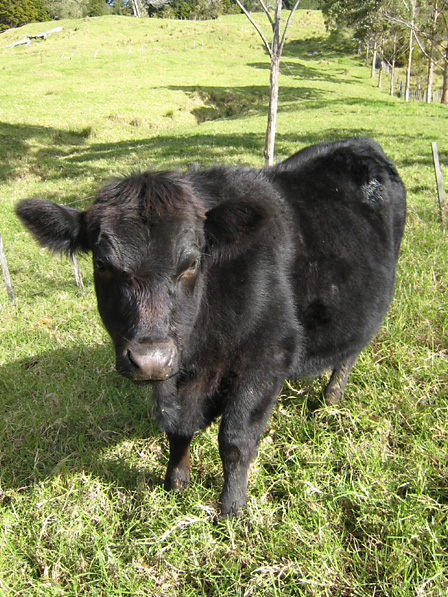
Lloyd Johnson has been providing home kill services in New Zealand for twenty years. He’s trying to retire from this work, but rural people continue to call on him. For a cost of $60, Lloyd will do the job neatly and efficiently.
Besides his years of experience, Lloyd brings with him a mobile slaughterhouse in the form of his specialized ute.
All the customer has to do is walk the cow to be slaughtered into the vicinity of that ute and Lloyd will do the rest.
I assumed that I’d do the same thing that I always did when I shifted the cows: Offer a treat bucket to Coco and then walk to where I wanted the rest of the cows to go. They all follow Coco. Except for that day, they didn’t. I don’t know if it was a coincidence, but they wouldn’t follow me down to the front of the paddock, where Lloyd was waiting with his rifle for Herman Beefsteak.
Long story short, eventually Lloyd and I managed to shift Herman into a desirable location for what was about to happen.
I wasn’t really sure how I would feel about slaughtering Herman Beefsteak. I felt… I suppose, matter-of-fact about the situation. From the day this animal was born, Becky and I both knew it would come to this. We gave the animal a care free, stress free life, and now it is going to feed and nourish us and our baby son, Owen. It’s not any more complicated than that for me.
Lloyd stepped close to the steer, aimed the rifle at its head—“Just above the point at which imaginary lines from alternate eyes and horns cross”—and pulled the trigger. The crack of the .22 calibre rifle was followed by great thump as the animal collapsed and rolled onto its right side.
“Get your buckets,” said Lloyd. Becky had instructed Lloyd that she would like to have blood to make black pudding. I retrieved our two stainless steel buckets. (Becky is writing a post dedicated to making the black pudding.)
Lloyd said, “The death throes can be strong. Watch those hooves.”
The animal convulsed powerfully a couple of times, and then settled down.
With one of my buckets in hand and ready, Lloyd cut a long opening, deep into the animal’s neck, severing the main veins and arteries.
Both the volume of blood and the pressure with which is emerged took me by surprise. In a short time, I had about two gallons of blood, far more than necessary for Becky’s black pudding, I was sure. Better to have too much than too little, I figured, and whatever was left over would go right onto the garden beds.
I immediately delivered the buckets of blood to Becky, who was standing by in the kitchen. You’ve got to move fast when making black pudding. She’ll tell you all about it.
Back outside, Lloyd was already at work.
I’m not going to try to describe exactly what he did. He’s such an expert at it, and so fast, that I’m at a bit of a loss to explain it, even though I watched him do it. Luckily, I took pictures.
At the time, I kept thinking, “How is this going to be a one man job?”
Lloyd makes use of clever implements. Probably, the most clever of all is the small hoist and winch system that he custom built onto the back of his ute. This machine deploys in a matter of seconds and allows him to raise the animal up for gutting. The back of the ute itself is all stainless steel, which facilitates the transport of the beef to the butcher in a sanitary manner.
He has metal chocks to position the beast on its back so that it doesn’t roll over as he’s skinning it on the ground.
He uses some kind of stainless steel rods with hooks on both ends to pull bits this way or that. (There’s probably a name for these, but I just don’t know what they’re called.) If he needs some tension applied to the flesh, he hooks one end of the rod in and then he hooks the other end onto a tendon or hoof or another bit of flesh that’s going to pull the way he wants. Look carefully at the pictures and you’ll see this much clearer than I can hope to explain it.
He has an obviously custom built, all metal ax. The blade looks like a heavy duty meat cleaver, but it has a full length ax handle. This is used to actually split the dressed carcass in half.
A high quality stainless steel saw was used once—and only very briefly—on the breast bone, I believe.
He sharpened his knife continuously with a sharpening steel that he wore around his waist.
He had a stainless steel brace that he wore over his shoulders and waist. This assists him with carrying the meat—in quarters—from the hoist to the back of the ute for transport.
He tows a trailer in which the animal’s head, hide and internal organs are carried away. He sells the hide. I don’t know what becomes of the head and the guts. We kept the heart, liver and kidneys.
The process was remarkably neat (considering the scale of the task) and seemed to happen very fast. How fast? You might not believe it, but the job was done in about thirty minutes.
Here’s the story, as told by the images. They run in order.
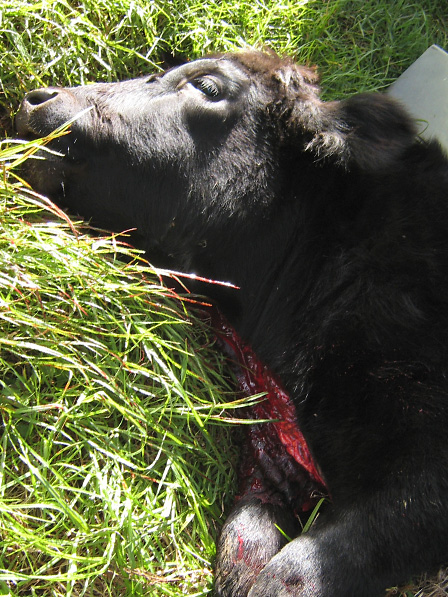


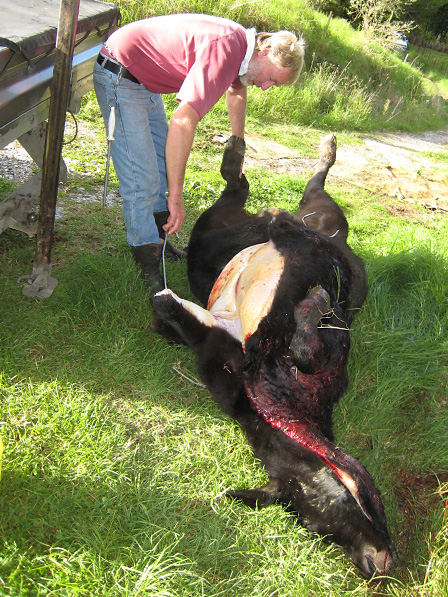








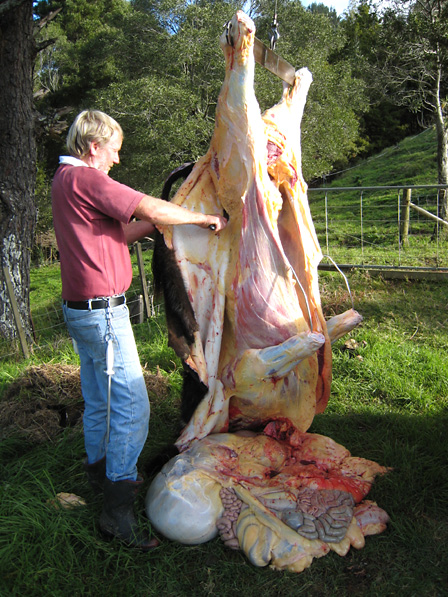




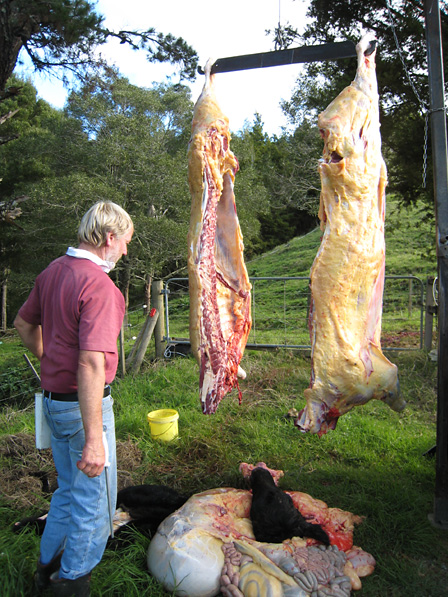
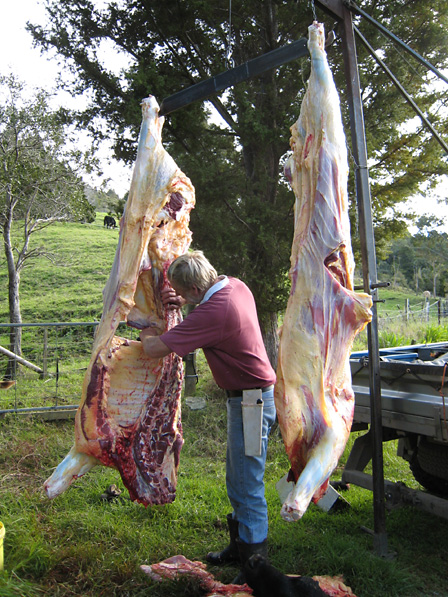


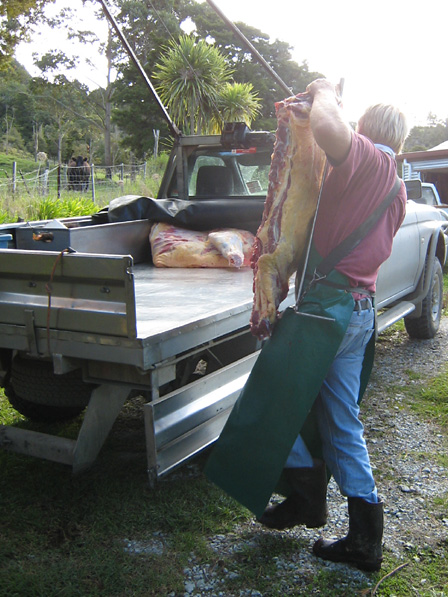

And away it all went to our butcher in town…
WARNING: THIS POST CONTAINS GRAPHIC IMAGES THAT MAY NOT BE SUITABLE FOR SOME READERS.
I apologize for taking so long to write this post. Even now, it’s not complete. I’m going to write the first two parts, and Becky is going to write the third.
The Far North of New Zealand is paradise for wild pigs. I have been here for nearly two years, but I only recently saw my first wild pig (alive). We have, however, seen evidence of pigs on our property, almost continuously. They root up the cow paddocks, bush areas and anywhere else that they might be able to find a feed.
So, I never actually saw one… Until, one evening, I was on my way to milk Coco when I happened to look up into one of our other paddocks. Rooting around, near a tree, was a good-sized, wild pig.
I dropped my milking buckets and quickly made for the house. I was so excited that I was a little bit out of my head.
I found Becky and said, “There’s a wild pig up in the paddock!”
“A wild pig!?” she asked, surprised.
“Should I shoot it?” I asked.
“Yes! Yes! Shoot it!” she snapped, “I want the blood and the lard, if it is any good!” Owen sucked away at her bosom, oblivious to the excitement.
With that, I unlocked the gun safe and removed our brand new Remington 870 Express Magnum 12 gauge pump shotgun. (Thank you, Farmlet and Cryptogon contributors.) I loaded the weapon with OO Buckshot. With four rounds in the magazine tube and one chambered, I was off to hunt the pig.
I stayed low and moved up the side of an embankment, so the pig couldn’t see me coming. I tried to move as quietly as possible. If I stood up a bit, I could just make out the pig through the tall grass.
When I was within about 15 metres, I tried to do a little review of what was about to happen. It was pretty simple, really, but I’d never done this before.
“Ok. I’m going to spring up into a firing position, aim for the head and pull the trigger.”

I have never shot an animal of this size before. Although I’d been shooting shotguns since I was about eight-years-old, it was always clays, paper targets, etc. I didn’t know what to expect. I knew that there was strong potential for me to make a serious mess of the meat with this weapon and the selected load. That was the only thing I was really sure about.
With that, I stood up to see what I could see, and shouldered my weapon.
The pig that I was stalking was right before me, exactly where I expected it to be. “It” was a large sow. But that’s not all I saw. Up and to the left was another big sow! And in the middle were something like six piglets, gorging themselves on roots and grubs in the freshly turned over soil.
The sow I was after hadn’t seen me yet—neither did the other sow, or the piglets. For a couple of fractions of a second, I considered my options.
From a conservation perspective, the more wild pigs that are killed, the better. (See: Economic and Environmental Risks from Feral Pigs in Northland.) Pigs are an introduced species and they wreak havoc on the native habitat. I have seen the damage that they (the pigs, not people, ahem!) do in native bush areas and it is unbelievable. It looks like a maniac with a bulldozer cleared the surface of all plant life. (Again, I’m talking about pigs, not people, ahem!) Our paddocks are routinely turned over by pigs… Our neighbors up the road, who have spent twenty years regenerating native bush on their land, mercilessly slaughter wild pigs, and get pig hunters in to get the more elusive ones. Recently, there was a boar on the property with an estimated weight of 150 pounds. Our neighbors have seen him, but nobody has been able to catch or kill the creature. They actually built a macro scale pig trap, which looks like a good sized horse corral, to try to catch him. They planned to place a succulent, young sow in there with a bunch of stinky dead possums in an attempt to lure hogzilla in there. But with all the attempts to capture or kill this boar, he apparently moved on to more hospitable tramping grounds.
But let’s keep our priorities straight: I came up here to get one pig. I decided to take the sow that I had my eye on all along, and then I would try to get the other sow. After that, I’d think about what to do about the piglets.
That was about the time that the sow I was gunning for lifted her head and looked right at me. I had her dead to rights, I placed the bead on her forehead. For an instant, I paused. The thoughts were a mixture of:
If I shoot her head-on, I’m going to make a mess of the meat.
I don’t want to shoot her, because, I actually think pigs are pretty cool, even though they wreak havoc on the place.
Pull the trigger, before you blow it and they all get away.
BOOOOOOOOM! went the roar of my cannon.
The pig dropped to the ground.
I cycled the pump action and swung the weapon toward the other sow. She was off like a flash, back into the bush block. I got nothing like a clean shot so I didn’t fire. I had no idea how fast a wild pig could move!
Piglets…
They were slipping away into the bush, after the other sow. Maybe I could have shot some of them, maybe not, but I didn’t pull the trigger.
I walked to within a few metres of the sow that I just shot. She was down, mortally wounded, but not dead. In all of the excitement, I didn’t take my hunting knife with me! The custom would be to stab the pig in the heart to finish it off, and drain the blood. Instead, I aimed the weapon at her head and fired.
That was it. I killed my first wild pig.
I loaded another round and went off to chase the rest of the mob. Of course, they were long gone.
I returned to my quarry. By that time, Becky was into her gumboots and headed up to see me. She had Owen in a pouch and she carried a big knife and a steel pot in which she wanted me to collect some blood so she could make blood pudding.
“Wow,” I thought to myself, standing in the pasture with my wife, my baby boy, my shotgun and a dead pig at our feet, “We are a long, long way from Irvine, California.”
But there was no time for dawdling. The sun was getting lower in the sky, and I had to butcher this pig. Somehow…
Part 2: Butchering the Pig
My only experience with butchering a pig involved watching one of Becky’s cousins do it once. In other words, I had an idea of what to do, but it was going to be really ugly; even uglier than it would be under the best of conditions. Becky suggested calling her cousin, Paul, to see if he could help me butcher this pig. That sounded like an excellent idea to me!
I proceeded as if Paul wouldn’t be able to help, since he’s very busy on his farm (not a farmlet, but a high stakes dairy farm). I took a rope and managed to get the pig strung up in a tree, head pointed down. Becky wanted the blood, so I was going to try to get some blood.
I set the metal bucket underneath the pig’s head and then I slit the pig’s throat. Some blood gushed into the bucket, but, unfortunately, some of whatever the pig had been eating when I shot it fell out of its mouth into the bucket with the blood. Woops. Ok. That didn’t go so well.
Before getting into the main job, I walked down to the house to see if Paul would be able to help me. Becky said he would help and that I should go over right away.
I managed to load the pig onto the back of our ute and then I drove over to Paul and Claire’s farm.
I pulled up and Paul looked at the pig.
“That’s a good sized pig,” he said, approvingly. We guessed the weight to be around 75 pounds.
We decided to go with the hot water method of taking the hair off the pig. Paul had an old bathtub especially for this job. We filled the bathtub about halfway with hot water. Then, Paul grabbed one side, I grabbed the other and into the bath went the pig.

The hot water makes it easier to take the hair off the pig, but you don’t want to actually start cooking the meat. After about a couple of minutes of sloshing the filthy, bloody carcass around in the water, we set about taking the hair off with our knives.

With the hair mostly off, Paul began to gut the pig. He went in from the back and worked toward the front. This is where the real expertise comes in handy. I don’t think it’s a good idea for me to try to write about this part because I’m sure there are much better materials to read about this aspect of the job than what I could possibly express here. In summary, everything back from the heart and lungs came out in one mass. Then the other bits. Decapitation followed. (See: Living Green Farm’s excellent pig slaughtering post as well as, Basic Butchering of Livestock & Game by John J. Mettler.
Next, we butchered the meat into different cuts. Paul directed my blade for one of the hind roasts, but, for the record, he was the primary butcher. Helpful Tip: Make sure you have a saw handy to take the ribs off the backbone, should you ever need to do this.

Here’s what we were left with.

* Phew * Wipe sweaty brow.
We bagged it all up and I took it home. Becky found room in the freezer for all of it.
Thanks, Paul and Claire, for all of your help, and for taking the pictures for this part of the story.
Part 3: Preparing the Feast
Kevin (Beloved Husband and Intrepid Hunter of Wild Pig) arrived home from my cousin Paul’s place very late on the night of that eventful day when he shot his first wild pig. He looked tired and grubby. He arrived carrying some dodgy-looking bags of meat product for me to fit into the freezer. Some of the bags seemed to be leaking on the kitchen floor. Something was smelling a bit gamey and musky. I was so pleased to see Kevin. I rushed over to give him a big kiss. “Don’t touch me. I stink!” he warned. On closer inspection, I decided not to argue with him.
The condition of the pork from Kevin’s pig was bound to be less than ideal for a couple of reasons:
* He couldn’t get exactly the angle he wanted, so there was a bit of shot in the meat.
* He didn’t have a knife with him to bleed the animal quickly after shooting it.
* We don’t have a suitable spot to hang the meat before butchering it.
Add to this the fact that wild pork is generally kinda hairy and gamey (Well, this is what I’ve been told by people who know and love it!!). As drips of wild pork blood leaked onto the kitchen floor and the musky essence of wild pig wafted through the house, I probed the limits of my optimistic imagination to envision the contents of the plastic bags as a tasty wild pork roast feast. It wasn’t easy!
“Oh god,” said Kevin, “What a mess. Do you think we’ll be able to eat it? Did Paul and Claire and I do all that for nothing?”
I looked up at my tired, smelly husband and smiled as confidently as I could: “Just you wait. It’ll be delicious. This will all seem worthwhile when we’re sitting down to a fine meal of wild pork.” I hoped my words would turn out to be true!
While Kevin was out at Paul’s place butchering the pig, I was busy at home. Once I’d put Owen to bed for the night, I got on the internet to do some research.
Blood Pudding? This was off the menu already, since Kevin hadn’t been able to bleed the pig cleanly. For the record, we couldn’t have made it anyway. You need to have all the other ingredients prepared in advance so that you can mix in the blood quickly before it congeals. I still want to try this when we home-kill our own beef, since blood is one of the best sources of vitamin D you can get. And I know blood pudding sounds a bit crusty to some, but it’s fine food to those who like it.
Lard? No way! Not from a wild pig. They are lean animals, quite different from plump domestic pork! The fat they do have is soft, gelatinous and undesirable.
I found lots of good information about soaking, marinating and cooking wild pork and other game — ways to make it less gamey and smelly, more tender etc.
This is what we did to prepare our wild pork feast:
1. Kevin cleaned a roast and made sure it had no shot left in it. He also skinned it, as it still looked pretty hairy.

2. We soaked it overnight in milk (as per Paul’s suggestion) — in a tightly sealed plastic bag in the fridge.
3. We rinsed the roast and marinated it for 24 hours in this “Tangy Beef or Pork Marinade” . Kevin perked up when he smelled the marinade. “This stuff could make an old boot taste good,” he declared. I wasn’t sure about the old boot, but I was praying the marinade would have a good effect on our wild pork.
4. We baked the roast low and slow for about three hours. As it cooked, we basted it with leftover marinade mixed with extra maple syrup. A delicious, rich, meaty smell filled the house.
When my parents arrived for dinner, we served the roast along with roast garden vegetables and a sauce made by boiling down the leftover glaze and marinade. The meat was tender and full of flavour. Thanks to Kevin, we were all happy — eating a delicious meal in the best of company!
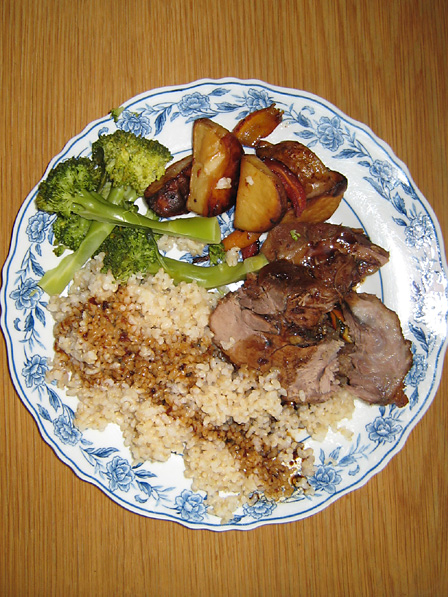
What happened to the rest of the meat?
* We gave a lot of it to a couple of kind neighbours who just love wild pork. One of them was horrified to hear that we’d skinned, soaked and marinated it. Apparently, he likes his pork boiled up with watercress — hair and all. . . but I suspect he has a stronger stomach than we do!
* We invited my parents to dinner again for another delicious roast, cooked in the same style as the first.
* I tried a slow-cooker experiment with some of the “chops and bits.” We skinned the meat and soaked it overnight in milk, as before. I assumed that we wouldn’t need to use a marinade if we were currying the meat in the slow cooker. I added lots of spices and yummy ingredients. Sadly, I must report that the result was repulsive! And the whole house smelt yucky for the duration of the cooking. Just as well we hadn’t invited my parents over to share this little number!
Will we be eating wild pork again in the foreseeable future? Maybe so. Kevin has seen signs that some of those wild piglets may still be in the area, and one of our neighbours is very keen to help with the butchering (and eating!) if Kevin can track one down and get a clean shot at it.